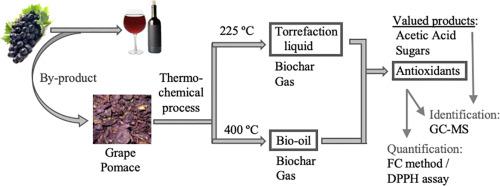当前位置:
X-MOL 学术
›
Fuel Process. Technol.
›
论文详情
Our official English website, www.x-mol.net, welcomes your feedback! (Note: you will need to create a separate account there.)
Production, identification, and quantification of antioxidants from torrefaction and pyrolysis of grape pomace
Fuel Processing Technology ( IF 7.5 ) Pub Date : 2021-01-01 , DOI: 10.1016/j.fuproc.2020.106602 Cristina del Pozo , Jordi Bartrolí , Santi Alier , Neus Puy , Esteve Fàbregas
Fuel Processing Technology ( IF 7.5 ) Pub Date : 2021-01-01 , DOI: 10.1016/j.fuproc.2020.106602 Cristina del Pozo , Jordi Bartrolí , Santi Alier , Neus Puy , Esteve Fàbregas

|
Abstract Wine production generates huge amounts of residues, with grape pomace (GP) being the main solid waste. This work attempted to determine whether the use of thermochemical treatments (pyrolysis (400 °C) and torrefaction (225 °C)) are suitable processes to transform GP to a value-added compounds source, paying special attention to phenolics. GP management through thermochemical treatments could then provide ecological and economic benefits. Composition of the liquid fractions was determined by GC–MS. Phenolic quantification was performed using Folin-Ciocalteu (FC) and DPPH assay. Firstly, the suitability of these methods was discussed: DPPH assay was used to quantify phenolics in all the samples; however, in FC method, reducing sugars could interfere in the measurement. The results showed that phenolics were mainly concentrated in the non-aqueous phase of bio-oil (pyrolysis process). It was also observed that these compounds not only came from the GP composition, but from lignin devolatilization during the thermochemical process. Apart from phenolics, bio-oil was also composed of other products, such as acetic acid or levoglucosan. Therefore, this study showed that intermediate pyrolysis is a suitable treatment to add value to GP within a biorefinery concept, turning the winemaking waste into a potential source of antioxidants, together with other value-added compounds.
中文翻译:

葡萄渣烘焙和热解中抗氧化剂的生产、鉴定和定量
摘要 葡萄酒生产会产生大量的残留物,其中葡萄渣(GP)是主要的固体废物。这项工作试图确定使用热化学处理(热解 (400 °C) 和烘焙 (225 °C))是否适合将 GP 转化为增值化合物来源,并特别关注酚类物质。然后通过热化学处理进行 GP 管理可以提供生态和经济效益。液体组分的组成由 GC-MS 确定。使用 Folin-Ciocalteu (FC) 和 DPPH 测定进行酚类定量。首先,讨论了这些方法的适用性: DPPH 测定用于定量所有样品中的酚类物质;然而,在 FC 方法中,还原糖可能会干扰测量。结果表明,酚类物质主要集中在生物油的非水相中(热解过程)。还观察到这些化合物不仅来自 GP 组合物,还来自热化学过程中的木质素脱挥发分。除了酚类物质外,生物油还由其他产品组成,例如乙酸或左旋葡聚糖。因此,这项研究表明,中间热解是一种合适的处理方法,可以在生物精炼概念中为 GP 增加价值,将酿酒废物与其他增值化合物一起转化为抗氧化剂的潜在来源。生物油还由其他产品组成,例如乙酸或左旋葡聚糖。因此,这项研究表明,中间热解是一种合适的处理方法,可以在生物精炼概念中为 GP 增加价值,将酿酒废物与其他增值化合物一起转化为抗氧化剂的潜在来源。生物油还由其他产品组成,例如乙酸或左旋葡聚糖。因此,这项研究表明,中间热解是一种合适的处理方法,可以在生物精炼概念中为 GP 增加价值,将酿酒废物与其他增值化合物一起转化为抗氧化剂的潜在来源。
更新日期:2021-01-01
中文翻译:

葡萄渣烘焙和热解中抗氧化剂的生产、鉴定和定量
摘要 葡萄酒生产会产生大量的残留物,其中葡萄渣(GP)是主要的固体废物。这项工作试图确定使用热化学处理(热解 (400 °C) 和烘焙 (225 °C))是否适合将 GP 转化为增值化合物来源,并特别关注酚类物质。然后通过热化学处理进行 GP 管理可以提供生态和经济效益。液体组分的组成由 GC-MS 确定。使用 Folin-Ciocalteu (FC) 和 DPPH 测定进行酚类定量。首先,讨论了这些方法的适用性: DPPH 测定用于定量所有样品中的酚类物质;然而,在 FC 方法中,还原糖可能会干扰测量。结果表明,酚类物质主要集中在生物油的非水相中(热解过程)。还观察到这些化合物不仅来自 GP 组合物,还来自热化学过程中的木质素脱挥发分。除了酚类物质外,生物油还由其他产品组成,例如乙酸或左旋葡聚糖。因此,这项研究表明,中间热解是一种合适的处理方法,可以在生物精炼概念中为 GP 增加价值,将酿酒废物与其他增值化合物一起转化为抗氧化剂的潜在来源。生物油还由其他产品组成,例如乙酸或左旋葡聚糖。因此,这项研究表明,中间热解是一种合适的处理方法,可以在生物精炼概念中为 GP 增加价值,将酿酒废物与其他增值化合物一起转化为抗氧化剂的潜在来源。生物油还由其他产品组成,例如乙酸或左旋葡聚糖。因此,这项研究表明,中间热解是一种合适的处理方法,可以在生物精炼概念中为 GP 增加价值,将酿酒废物与其他增值化合物一起转化为抗氧化剂的潜在来源。



























 京公网安备 11010802027423号
京公网安备 11010802027423号